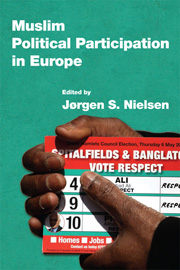Book contents
- Frontmatter
- Contents
- List of tables and figures
- 1 Introduction
- Part One Laying foundations: national and local elections
- Part Two Participation as integration
- 7 Muslim collective mobilisations in contemporary Europe: new issues and new types of involvement
- 8 How politically integrated are Danish Muslims? Evidence from the Muhammad cartoons controversy
- 9 Limits and potentialities of the Italian and British political systems through the lens of Muslim women in politics
- 10 Representing ‘Islam of the banlieues’: class and political participation among Muslims in France
- Part Three Institutions as gateways
- Part Four Breaking the bounds
- Notes on the contributors
- Index
7 - Muslim collective mobilisations in contemporary Europe: new issues and new types of involvement
from Part Two - Participation as integration
Published online by Cambridge University Press: 05 October 2013
- Frontmatter
- Contents
- List of tables and figures
- 1 Introduction
- Part One Laying foundations: national and local elections
- Part Two Participation as integration
- 7 Muslim collective mobilisations in contemporary Europe: new issues and new types of involvement
- 8 How politically integrated are Danish Muslims? Evidence from the Muhammad cartoons controversy
- 9 Limits and potentialities of the Italian and British political systems through the lens of Muslim women in politics
- 10 Representing ‘Islam of the banlieues’: class and political participation among Muslims in France
- Part Three Institutions as gateways
- Part Four Breaking the bounds
- Notes on the contributors
- Index
Summary
Muslims in the European Union have different visions of their religion, and often they are contradictory. Their attitudes towards the letter of the religion range from a strict adherence to practice to a critical attitude towards the rituals (Frégosi 2011). Indeed, a lot of Muslims do not use their faith as the only lens through which they interpret reality and are active within society.
It is important to discuss the different forms of mobilisation that these populations use, either one at a time or combined. We will use the ideal typical categories of mobilisation forms to study how they stage the complex relations between European Muslims and their religion, and how the fact of being a Muslim plays a part in the mobilisation process, at what level, under what form and to what end. In this chapter we will try to understand how the different ways of being Muslim (believing with or without belonging to an organised Muslim community, secular Muslims, Muslim cultural backgrounds only, etc.) are directly connected to different ways of involvement within the European societies. In another words, does Islam have any influence on the degree of integration and political commitment in French and other European societies?
- Type
- Chapter
- Information
- Muslim Political Participation in Europe , pp. 129 - 139Publisher: Edinburgh University PressPrint publication year: 2013



